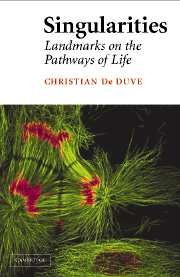Book contents
- Frontmatter
- Contents
- Foreword
- On Christian de Duve: An Editor's Appreciation
- General Introduction
- 1 Building Blocks
- 2 Homochirality
- 3 Protometabolism
- 4 ATP
- 5 Electrons and Protons
- 6 Thioesters
- 7 RNA
- 8 Proteins
- 9 DNA
- 10 Membranes
- 11 Protonmotive Force
- 12 Protometabolism Revisited
- 13 The LUCA
- 14 The First Fork
- 15 Eukaryotes
- 16 Oxygen
- 17 Endosymbionts
- 18 Multicellulars
- 19 Homo
- 20 Evolution
- Final Comments
- Bibliography
- Index
19 - Homo
Published online by Cambridge University Press: 18 January 2010
- Frontmatter
- Contents
- Foreword
- On Christian de Duve: An Editor's Appreciation
- General Introduction
- 1 Building Blocks
- 2 Homochirality
- 3 Protometabolism
- 4 ATP
- 5 Electrons and Protons
- 6 Thioesters
- 7 RNA
- 8 Proteins
- 9 DNA
- 10 Membranes
- 11 Protonmotive Force
- 12 Protometabolism Revisited
- 13 The LUCA
- 14 The First Fork
- 15 Eukaryotes
- 16 Oxygen
- 17 Endosymbionts
- 18 Multicellulars
- 19 Homo
- 20 Evolution
- Final Comments
- Bibliography
- Index
Summary
Highlighted by a few discoveries that have inflamed the imagination of the greater public, the history of our origins has become, thanks to modern means, an object of intensive investigations and discussions, related in numerous recent works. Little of this will be covered in the present chapter, which, like the preceding one, will be limited to data directly relevant to the main topic of this book.
A Bird's-Eye View of Human Evolution
Figure 19.1 brings together some illuminating clues to the ancient, still poorly understood pathway whereby our species has evolved from the last ancestor we have in common with chimpanzees, our closest extant relatives. In this graph, some of the better-known hominids are represented, on one hand, by the approximate time range of their existence and, on the other, by their estimated brain size, the most dramatically changing parameter of this crucial development. Several features of this graph deserve to be noted.
First, there are two landmark singularities. The first goes back to the time, between five and seven million years ago, when the human line separated from that leading to chimpanzees. According to currently available evidence, all known hominid branches seem to be offshoots of this single line. The second singularity, which is solidly established by molecular data, indicates the origin, roughly 200000 years ago, of all modern humans worldwide from a single ancestral group, often reduced in the popular press to a single couple some commentators do not hesitate to identify with the biblical Adam and Eve.
- Type
- Chapter
- Information
- SingularitiesLandmarks on the Pathways of Life, pp. 221 - 230Publisher: Cambridge University PressPrint publication year: 2005

